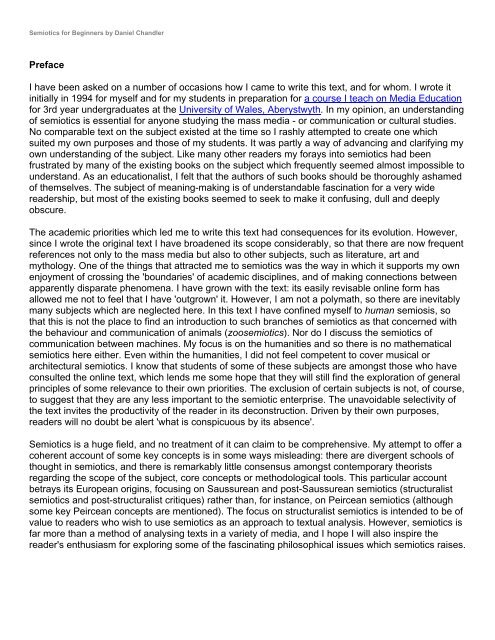Semiotics for Beginners by Daniel Chandler
Semiotics for Beginners by Daniel Chandler
Semiotics for Beginners by Daniel Chandler
Create successful ePaper yourself
Turn your PDF publications into a flip-book with our unique Google optimized e-Paper software.
<strong>Semiotics</strong> <strong>for</strong> <strong>Beginners</strong> <strong>by</strong> <strong>Daniel</strong> <strong>Chandler</strong><br />
Preface<br />
I have been asked on a number of occasions how I came to write this text, and <strong>for</strong> whom. I wrote it<br />
initially in 1994 <strong>for</strong> myself and <strong>for</strong> my students in preparation <strong>for</strong> a course I teach on Media Education<br />
<strong>for</strong> 3rd year undergraduates at the University of Wales, Aberystwyth. In my opinion, an understanding<br />
of semiotics is essential <strong>for</strong> anyone studying the mass media - or communication or cultural studies.<br />
No comparable text on the subject existed at the time so I rashly attempted to create one which<br />
suited my own purposes and those of my students. It was partly a way of advancing and clarifying my<br />
own understanding of the subject. Like many other readers my <strong>for</strong>ays into semiotics had been<br />
frustrated <strong>by</strong> many of the existing books on the subject which frequently seemed almost impossible to<br />
understand. As an educationalist, I felt that the authors of such books should be thoroughly ashamed<br />
of themselves. The subject of meaning-making is of understandable fascination <strong>for</strong> a very wide<br />
readership, but most of the existing books seemed to seek to make it confusing, dull and deeply<br />
obscure.<br />
The academic priorities which led me to write this text had consequences <strong>for</strong> its evolution. However,<br />
since I wrote the original text I have broadened its scope considerably, so that there are now frequent<br />
references not only to the mass media but also to other subjects, such as literature, art and<br />
mythology. One of the things that attracted me to semiotics was the way in which it supports my own<br />
enjoyment of crossing the 'boundaries' of academic disciplines, and of making connections between<br />
apparently disparate phenomena. I have grown with the text: its easily revisable online <strong>for</strong>m has<br />
allowed me not to feel that I have 'outgrown' it. However, I am not a polymath, so there are inevitably<br />
many subjects which are neglected here. In this text I have confined myself to human semiosis, so<br />
that this is not the place to find an introduction to such branches of semiotics as that concerned with<br />
the behaviour and communication of animals (zoosemiotics). Nor do I discuss the semiotics of<br />
communication between machines. My focus is on the humanities and so there is no mathematical<br />
semiotics here either. Even within the humanities, I did not feel competent to cover musical or<br />
architectural semiotics. I know that students of some of these subjects are amongst those who have<br />
consulted the online text, which lends me some hope that they will still find the exploration of general<br />
principles of some relevance to their own priorities. The exclusion of certain subjects is not, of course,<br />
to suggest that they are any less important to the semiotic enterprise. The unavoidable selectivity of<br />
the text invites the productivity of the reader in its deconstruction. Driven <strong>by</strong> their own purposes,<br />
readers will no doubt be alert 'what is conspicuous <strong>by</strong> its absence'.<br />
<strong>Semiotics</strong> is a huge field, and no treatment of it can claim to be comprehensive. My attempt to offer a<br />
coherent account of some key concepts is in some ways misleading: there are divergent schools of<br />
thought in semiotics, and there is remarkably little consensus amongst contemporary theorists<br />
regarding the scope of the subject, core concepts or methodological tools. This particular account<br />
betrays its European origins, focusing on Saussurean and post-Saussurean semiotics (structuralist<br />
semiotics and post-structuralist critiques) rather than, <strong>for</strong> instance, on Peircean semiotics (although<br />
some key Peircean concepts are mentioned). The focus on structuralist semiotics is intended to be of<br />
value to readers who wish to use semiotics as an approach to textual analysis. However, semiotics is<br />
far more than a method of analysing texts in a variety of media, and I hope I will also inspire the<br />
reader's enthusiasm <strong>for</strong> exploring some of the fascinating philosophical issues which semiotics raises.




